B2B content marketing is creating and promoting content to attract other businesses that are your target customers.
Content marketing is essential for B2B businesses because education prospects help them make buying decisions.
According to Statista, 30% of marketers say content marketing offers the highest ROI of any digital marketing channel. Furthermore, in HubSpot’s State of Inbound Marketing Trends 2022, content marketing is one of the top three marketing strategies for B2B brands.
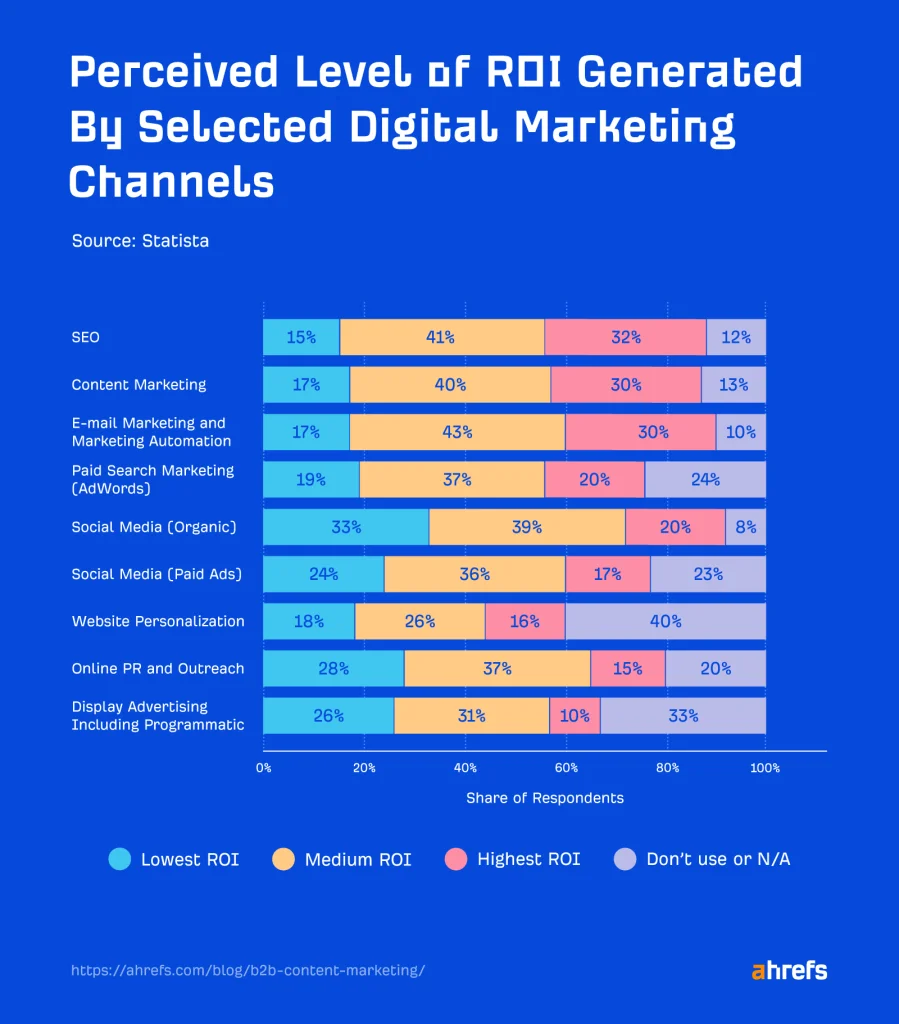
There are also plenty of real-life examples. Ahrefs, HubSpot, Shopify, Animalz, and Deloitte are some of many that have succeeded with this marketing type.
In this guide, I’ll explain how we do content marketing at Ahrefs, a B2B business.
How is B2B content marketing different from B2C content marketing?
There are two main differences between B2B and B2C content marketing.
1. More decision-makers
Generally speaking, there are more decision-makers involved in the B2B buying process. There are plenty of times when the person using the product or service is different from the one buying it.
For example, an in-house SEO may be the one using our toolset, but the chief marketing officer (CMO) or chief financial officer (CFO) may be the one who approves the purchase.
As a result, your content will need to target more than just the operator alone. It’ll also have to help the operator convince other relevant stakeholders to purchase your product or service.
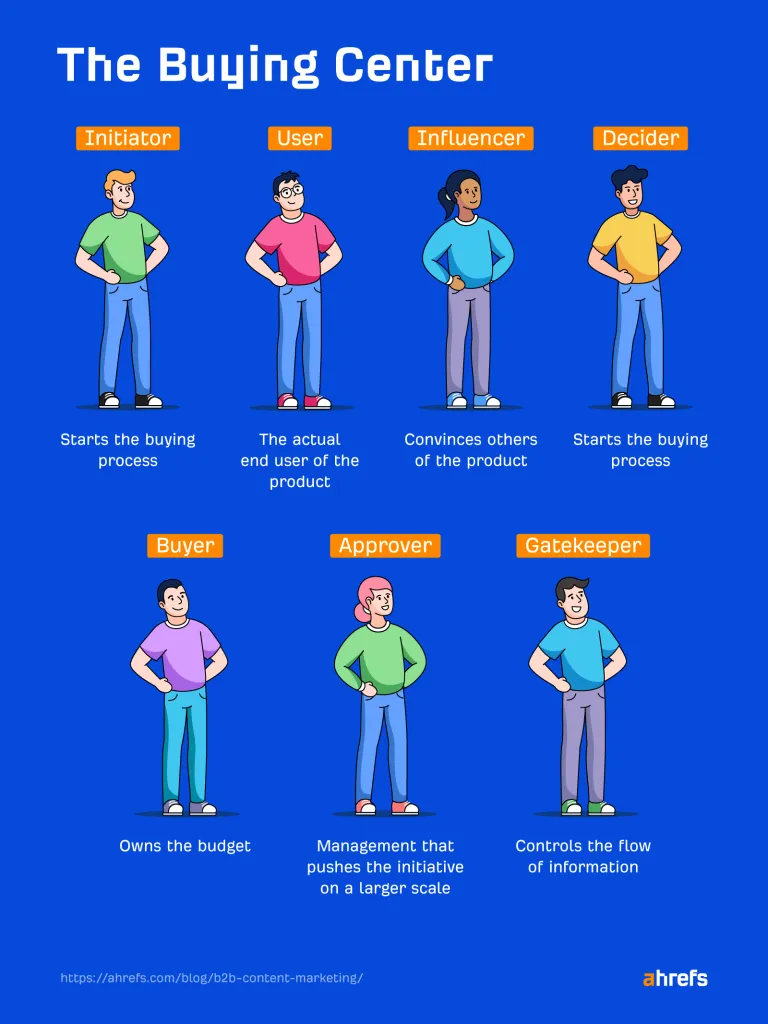
For B2C, the person buying is usually the person making the buying decision.
2. Buying motivation
Most B2B buyers are purchasing for the value you offer, specifically how you help them solve their problems.
So you’ll have to prove that value using your content. You’ll also have to show you are trustworthy, you know your stuff, and that other brands have used your product or service successfully.
On the other hand, the buying motivation for most B2C products can be more impulsive, e.g., food, fashion, games, electronics, etc.
How to do B2B content marketing, the Ahrefs way
There is no one right way to do content marketing for B2B. Your content marketing will differ depending on what you sell, whom you sell to, and your goals.
As such, it’s impossible to cover every potential variation of the B2B content marketing strategy in this guide. Instead, I’ll focus on how we do B2B content marketing at Ahrefs. Hopefully, that’ll inspire your own.
Our B2B content marketing strategy is simple: We focus on creating content about topics that have search traffic potential, business potential, and ranking potential.
Here’s how we do it:
1. Find relevant topics with search traffic potential
Your content must be discovered by your target audience for it to be consumed. The best way to do this is for your content to rank high on Google.
So rather than treat SEO as an afterthought, we want to build it into our content marketing. We can do this by targeting topics that our target customers are searching for.
Here’s how to find these topics:
- Go to Ahrefs’ Keywords Explorer
- Enter a few broad keywords related to your site or niche (e.g., we can look for keywords like marketing and seo)
- Go to the Matching terms report
- Filter for keywords with Traffic Potential (TP)
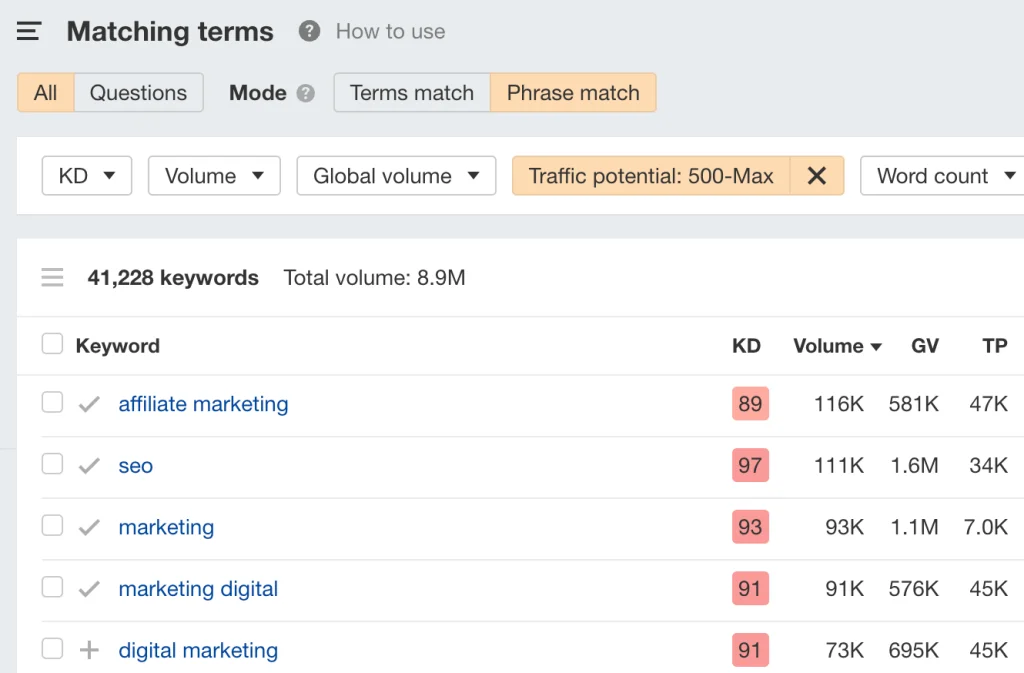
Traffic Potential is the estimated monthly organic search traffic to the top-ranking page for a keyword. Since pages tend to rank for many similar keywords and not just one, TP is a more reliable estimate of search traffic than search volume.
From here, you’ll want to go through the report to find keywords your potential customers are searching for.
2. Check its business potential
Cameron Brown, a content strategist at content marketing agency Grow & Convert, writes:
Outside of the most revolutionary, category-creating products and services, almost every B2B business already has a group of people who are at the purchase stage, looking to solve their problems with a product or service like yours.
Even though the ideal end state is to target every topic that can build your brand awareness, you’ll want to prioritize those that can send you actual leads and customers (at least for now).
At Ahrefs, we assign a “business potential” score to each topic. And business potential is how easy it will be to pitch your product while covering a given keyword.
Here’s the “cheat sheet” we use:
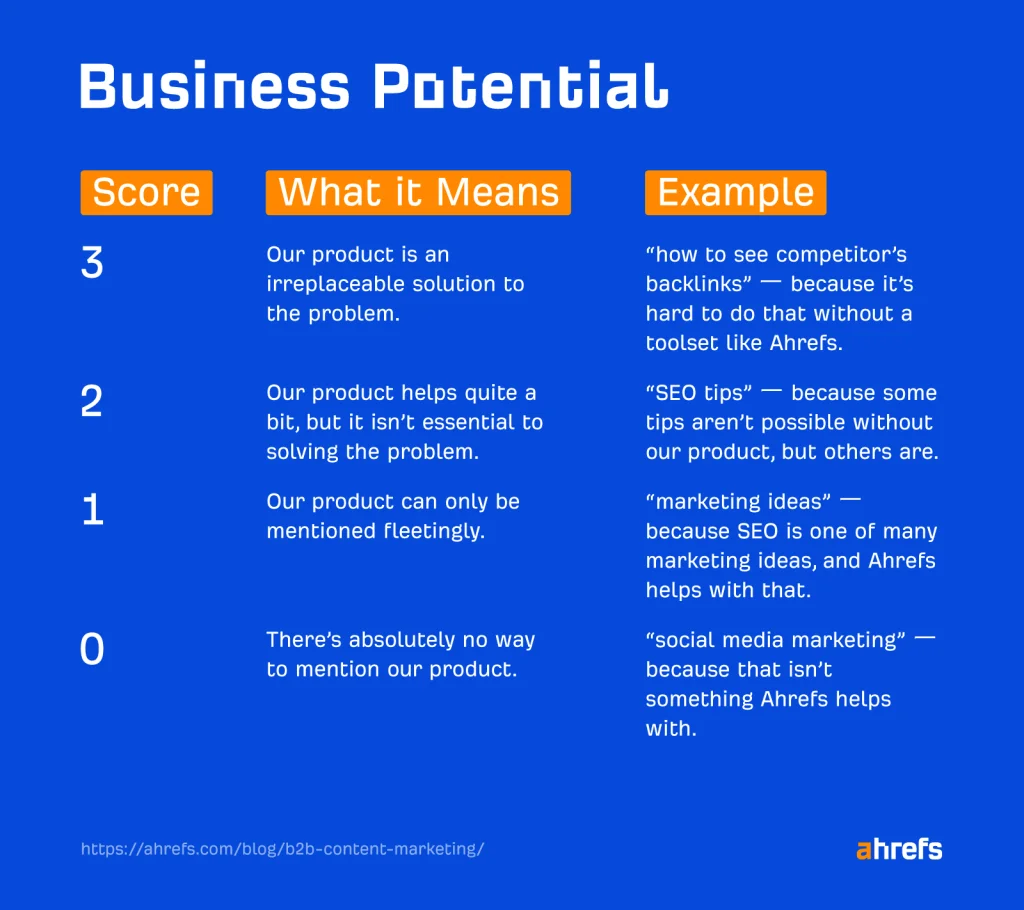
Go through each keyword you’ve pulled from step #1 and give them a score from 0 to 3.
3. Analyze each of their ranking potential
Some keywords are harder to rank than others. That’s to be expected because there are only limited “slots” for each keyword on the SERPs. So while that doesn’t mean you completely avoid difficult keywords (especially if they have business value), you should take ranking difficulty into account when targeting them.
For us, a keyword has ranking potential when it’s viable for us to rank in the top three with our available resources.
How do we know this? We look at the SERPs and assess three things:
Backlinks
Specifically, the quantity and quality of backlinks.
Backlinks are important because they’re one of Google’s top ranking factors. So if the pages you’re competing with have a lot of high-quality backlinks, it will be difficult to compete.
To see how many backlinks the competing pages have, enter your topic into Keywords Explorer and scroll down to the SERP overview. You’ll see how many referring domains and backlinks each top-ranking page has:
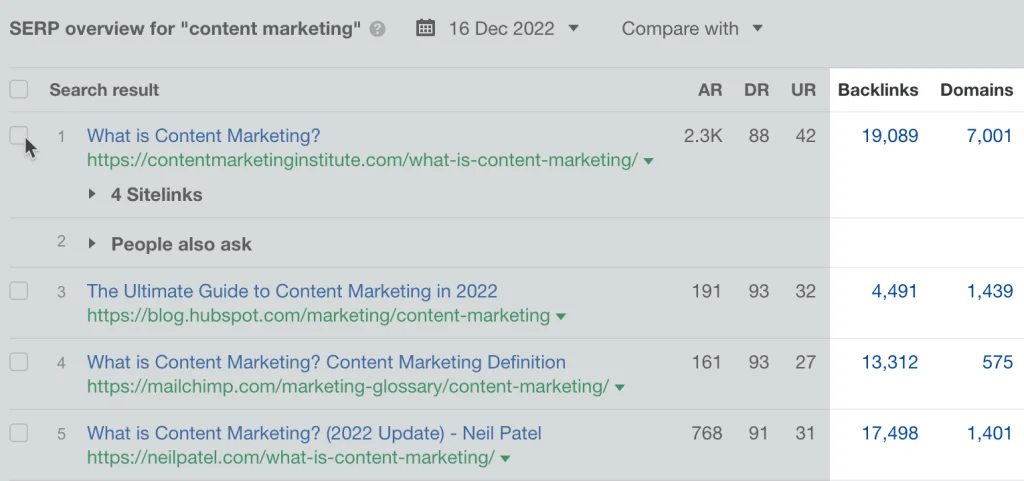
You can see that the topic content marketing is super competitive, with each page having thousands of backlinks. Compare that to B2B content marketing:

These numbers, however, only tell you about the quantity of backlinks. To assess quality, click on any of the numbers. This will bring you to each page’s backlink profile.

Eyeball the report and get a sense of the quality of backlinks the sites have using the guide below.
Authority
Website authority is an SEO concept that refers to the overall “strength” of a domain. In this case, “strength” refers to the likelihood of a domain to rank high on the SERPs.
Even though Google representatives said Google doesn’t evaluate website authority, many SEOs still believe authoritative websites have an easier time ranking. As such, they typically take a website authority metric, such as Domain Rating (DR), into account when assessing ranking difficulty.
If you’re on that side as well, you can easily see the top-ranking pages’ DR scores in the SERP overview section:
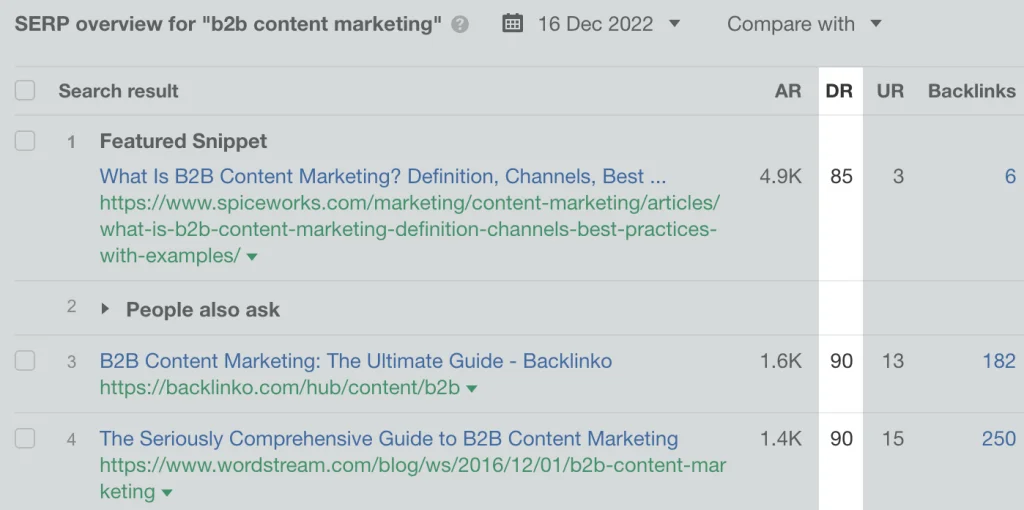
Content quality
The best content is one that provides more value in less time (and that includes entertainment value!).
You’ll want to make sure you’re able to deliver on that front too—if you wish to beat the top-ranking pages.
Here are a few questions you can ask while you’re assessing the content quality of the top-ranking pages:
- Does it provide accurate and up-to-date information?
- Is it written by a subject matter expert?
- Does it contain unique information?
- Does it cover the topic in full?
- Is it well written?
- Is it properly formatted?
- Is it well designed?
If they’re missing a few of these aspects, it’s your chance to beat them.
4. Create content for these topics
You now have a list of topics that have:
- Search traffic potential
- Business potential
- Ranking potential
It’s time to create content that’ll rank for these topics. Here’s how:
Match search intent
Google wants to rank relevant content. It does this by constantly figuring out why the searcher is making that query and then serving content that fulfills that. This is known as search intent.
If you want to rank high on Google for your target keywords, you have to match search intent. We can do this by analyzing the SERPs for the three Cs:
- Content type – Are they blog posts, landing pages, product pages, or something else?
- Content format – Are they listicles, how-tos, recipes, tools, or something else?
- Content angle – Is there a dominant selling point, like how easy it is?
For example, let’s say we want to target the topic how to drive traffic to your website.

Analyzing the three Cs, we get:
- Content type – They’re all blog posts.
- Content format – Despite the “how to” modifier, searchers are actually looking for lists.
- Content angle – There are a variety of angles here, from “proven” to “free and paid.”
If we’re creating content for this topic, we’ll have to create something similar. (Which we did, and we’re now ranking in position #5.)
Cover the topic in full
The best result for a query usually covers everything the searcher wants to know.
Here are two ways to find potential subtopics to cover:
- Look for common subheadings among top-ranking pages – If most of them have a similar subheading, then it’s likely important.
- Look for common keyword rankings among top-ranking pages – These are often important subtopics to cover.
Here’s how to execute the second method:
- Go to Ahrefs’ Keywords Explorer
- Enter your target keyword
- Select a few top-ranking pages in the SERP overview
- Click “Open in” and choose “Content gap”
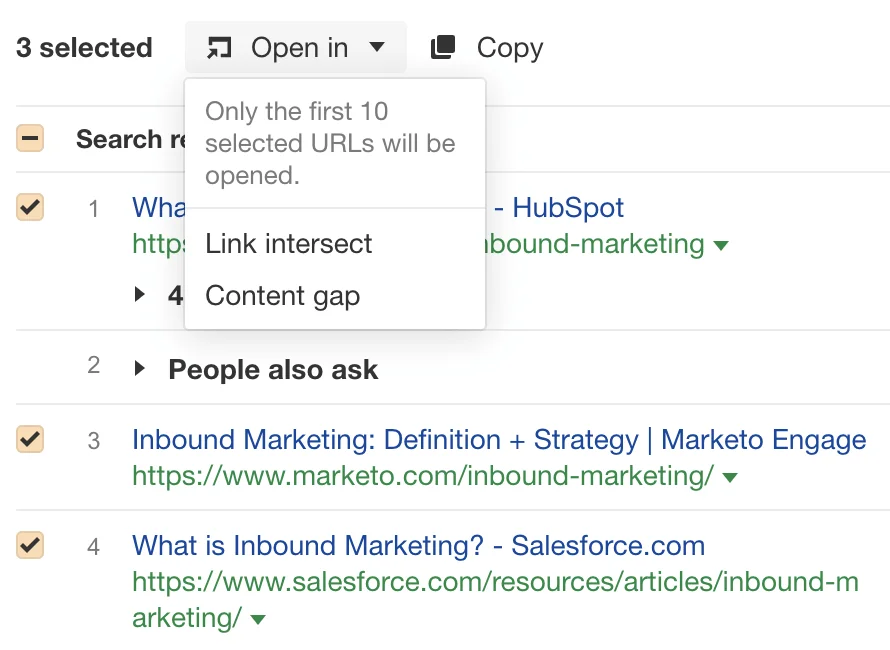
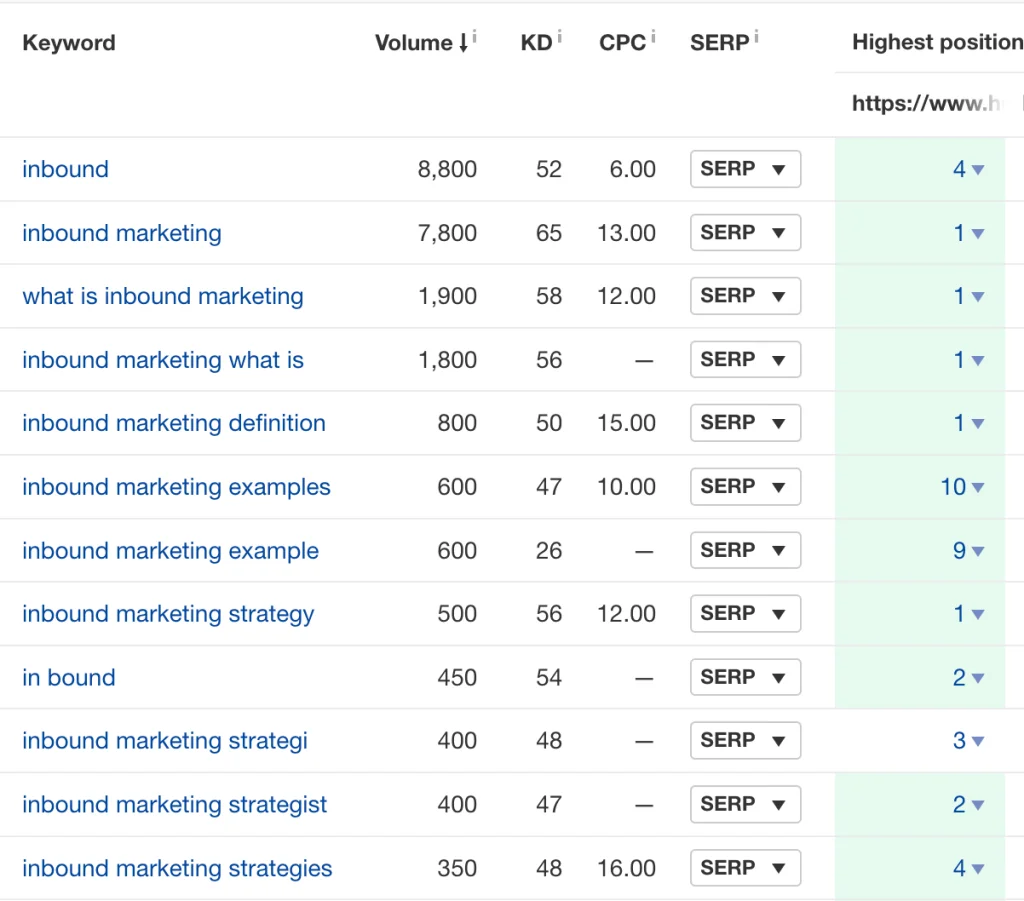
In this example, we’re targeting inbound marketing, and we can see a few subtopics to cover:
- What is inbound marketing
- Inbound marketing examples
- Inbound marketing strategies
- Inbound marketing tools
And more.
Make it unique
We want to match search intent and cover the topic in full. But we don’t want to create copycat content that no one wants to read.
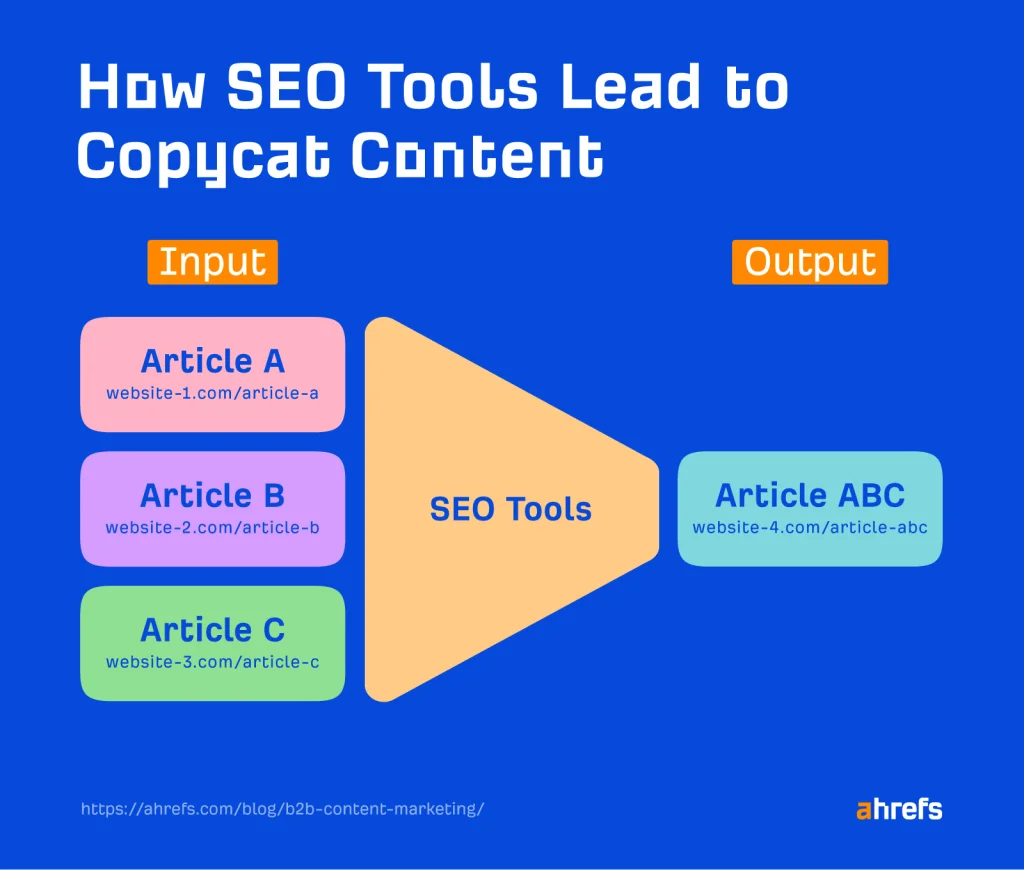
Not only is copycat content not useful for your readers and your business, it’s also detrimental to your SEO efforts because there’s no incentive to link to it. With Google filing a patent for information gain, unoriginal content may also be deprioritized and rank lower in the future.
To solve this, you need to create something unique. That can be a unique angle or unique ideas within your content.
For example, we could have created a generic B2B content marketing guide. Instead, we decided our personal experience doing B2B content marketing would be more interesting, helpful, and even stand out amongst the SERPs. (Do you agree? 😁)
If you’re struggling to come up with unique angles or ideas, here are a few prompts that may help:
- Personal experience – If you’ve successfully (or even unsuccessfully) done something, write about it.
- Expert interviews – Reach out and interview experts in your field or ask them to contribute an opinion to your piece.
- Crowdsource – Get multiple people to contribute their opinions, expertise, and ideas.
- Original research – Add data to your post. You can do this by running a study, survey, or poll.
- Contrarian – Be the devil’s advocate. Consider an opposing viewpoint.
5. Promote your content
Your content will practically be invisible if you don’t put it in front of people who care. Here are a few ways you can promote your content.
Create a weekly newsletter
At Ahrefs, we send a weekly newsletter to 200,000+ people with our latest content:
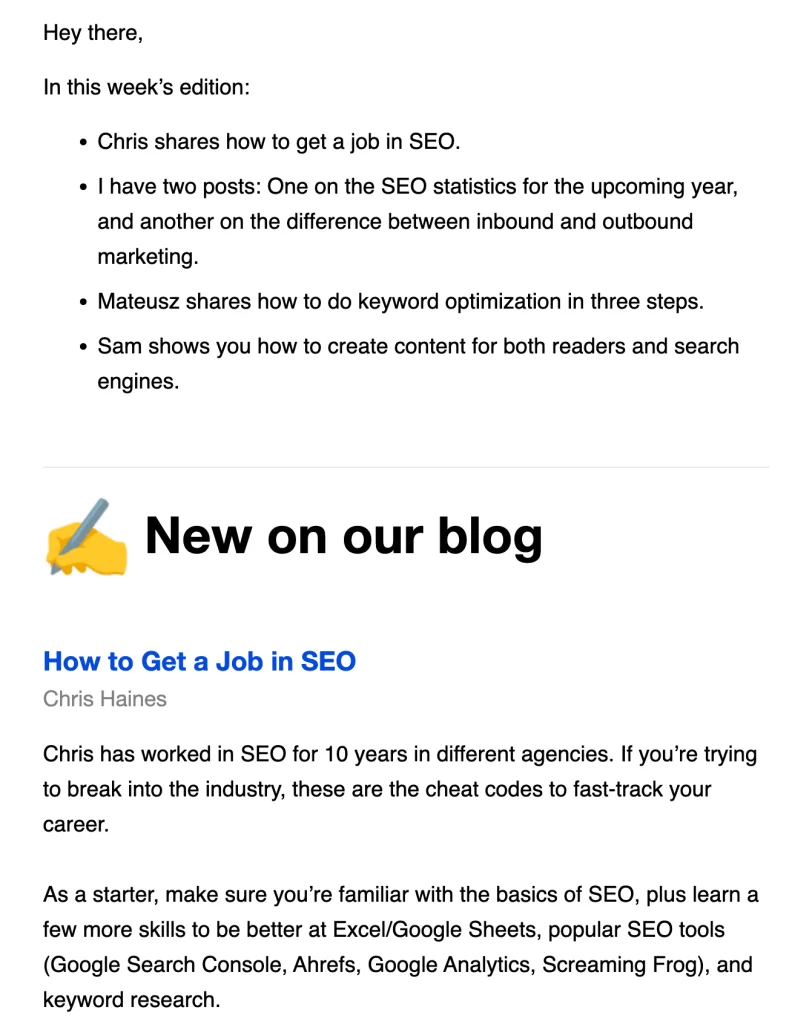
An email list is one of the best ways to distribute your content. You can directly reach people who want to hear more from you.
Unlike social media platforms, you are less likely to be restricted, prevented, or blocked from accessing your audience. You own the list.
The best way to grow your email list is to offer something in return for subscribing. This can be an ebook, an email course, a PDF, or more. For example, Intercom offers a free guide for download. This is shown as a sticky opt-in box on the side or at the end of the article:

Build a personal brand on LinkedIn
According to HubSpot’s State of Inbound Marketing Trends 2022, B2B brands are more likely to use LinkedIn and find it effective. That makes sense—after all, LinkedIn bills itself as the “social network for professionals.”
I asked David Fallarme, a marketing consultant, for his best tips on how to grow a personal brand on LinkedIn. Here’s what he shared:
Most people starting their LinkedIn journey obsess and agonize over what to publish. This takes them hours, if not days (or even weeks) to finally publish something. Then, they barely get any engagement and swear off publishing on LinkedIn.
For most people going from zero to one on LinkedIn, the way to get engagement on your content is to give engagement to other content first.
Your first job: to find and add people who are relevant to you and your target audience. Add a few influencers in your niche, then use the “People also viewed” function to see who else LinkedIn suggests. These are typically people who post regularly, which means you’ll be exposed to a lot of content in your niche.
After following ~10 – 15 influencers, you should build your LinkedIn writing muscle by commenting on their posts whenever you log on. This does a couple of things: first, it trains your brain that posting on LinkedIn is nothing to be scared of. Two, it gives you new ideas for your own content—every comment you leave is the seed for future posts. Third, when you leave thoughtful comments, and when you reply to others who have left comments, others who also follow that person will visit your profile and respond to your connection requests.
All of these increase the chances that when you post something on LinkedIn, it’s relevant to your target audience and you’re not just yelling into the void. You always have new connections who are exposed to your content.David Fallarme Marketing Advisor
Repurpose your content
Make your content go the extra mile by turning it into multiple formats.
For example, we turned our video on holiday SEO into a post. We also turned our post on whether SEO is worth it into a video.
Build links with link bait
We’ve established that links are important. But link building is hard. It’s even harder if you don’t have an existing brand or reputation. Worse still, people may even ask you to pay for links—a massive no-no in Google’s eyes.
If links are crucial, but link building is difficult, how do you get links? Well, the simplest answer is to earn it.
Some pages naturally earn links better than others. In the SEO world, they’re known as “link bait.” Take, for example, our study where we found 90.63% of pages get no search traffic. That article received 6,500 backlinks from 2,900 referring domains:
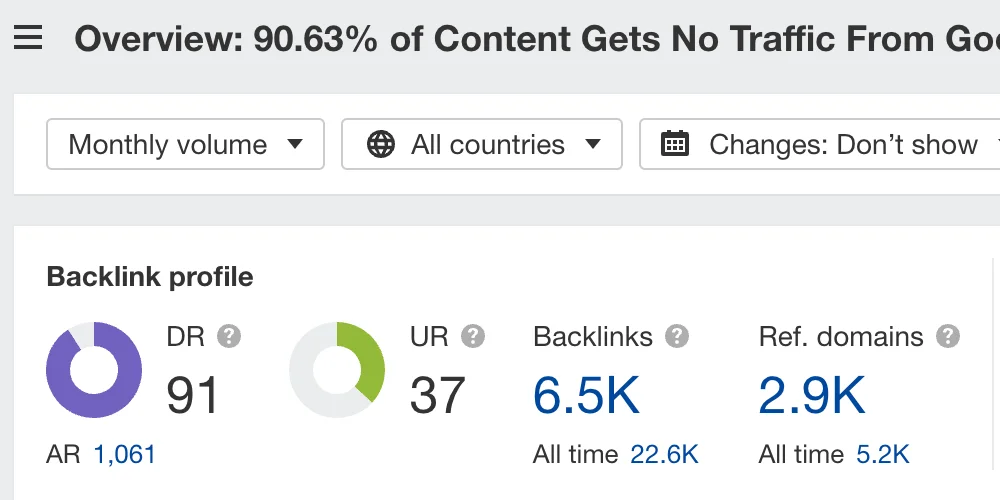
If you can create more link-earning pages, you can add internal links from those pages to your other content, thereby potentially boosting their rankings.
Here’s how to find good link bait ideas:
- Enter your competitor’s domain into Ahrefs’ Site Explorer
- Go to the Best by links report
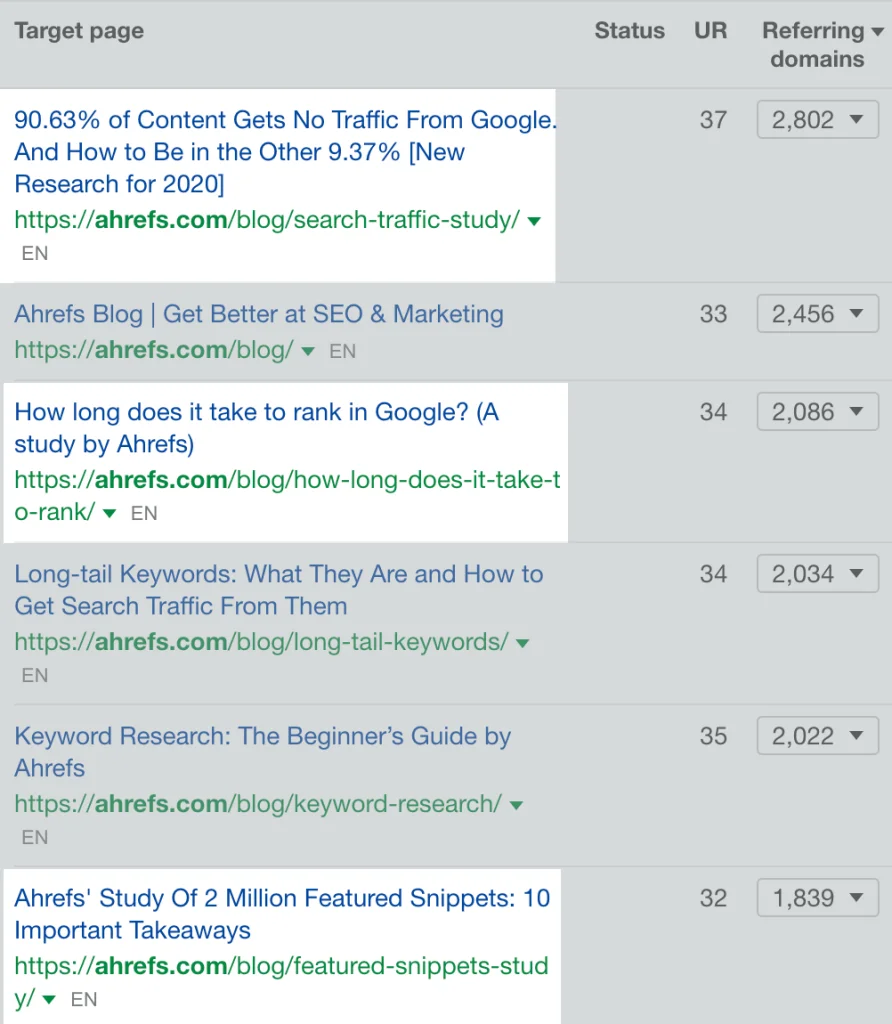
Eyeball the report to see what kind of formats and topics resonate with people in your niche. For example, we can see that the SEO industry loves data studies, which is why we’ve been consistently producing them.
Run ads
If you have the budget, you can always run ads to promote your content. If the big networks are scary and too expensive, consider smaller networks too.
For example, we run ads for our content on Quora:

Final thoughts
We’ve been following this strategy religiously for the past few years, and it has worked well for us. Hopefully, our content marketing strategy has inspired your B2B content marketing strategy.
Source from Ahrefs
Disclaimer: The information set forth above is provided by Ahrefs independently of Alibaba.com. Alibaba.com makes no representation and warranties as to the quality and reliability of the seller and products.




